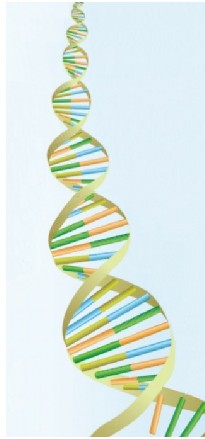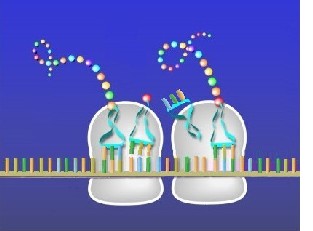
| Deciphering the Human Genome |
But what genes are made of and what they look like remained unexplained for a long time.
 | |
|
However, then the American researchers George Beadle and Edward Tatum discovered that genes direct the production of proteins, and the proteins in turn are responsible for the development of traits (e.g. body size, hair color, shape of the nose, etc.).
And in 1944 the chemist Oswald Avery proved that
Nevertheless, most of the scientists were still skeptical. It was not until eight years later that the consensus changed. DNA was declared to be the hereditary substance. Now an unprecedented race began to find out as fast as possible what the hereditary substance actually looked like.
In 1951 the x-ray expert Rosalind Franklin was successful in making the first structural x-rays of DNA. They were pictures consisting only of points, but the arrangement of the points delivered significant information about what DNA could look like.
Cambridge (England) – 1953. The two young scientists, James Watson and Francis Crick, saw the structural x-rays made by Rosalind Franklin, and more and more, their thoughts revolved around the topic of DNA. They decided to solve the puzzle of the structure of DNA by constructing a model using pieces of cardboard and building blocks. As they moved these back and forth it suddenly became clear to them how the building blocks had to be connected to each other so that all of the information from the structural x-rays would fit into the puzzle. The structure of DNA was like a rope ladder twisted into a cork-screw shape!
At that time experienced scientists might have smiled somewhat derisively at such a model, but Watson and Crick won the race with this method and unlocked the secret of heredity:
DNA looks like a sheer endless, twisted rope ladder. The ropes of the ladder are made of a sugar alternating with a phosphate acid. The rungs of the spiral ladder consist of four chemical substances which are called bases. These bases are named A = adenine, T = thymine, C = cytosine, G = guanine.
It soon became evident that this chain of four bases contains a code for producing all of the building blocks of the body. Twelve years later the code was deciphered successfully. Groups of three bases each give an instruction designed for the cellular protein factories. For instance, the instruction of the triplet code "AGT" reads as follows: "Take the component called serine and tie it to the end of the building block chain which is presently under construction." Then additional codes follow and the building blocks are thus assembled one after the other to form a protein. , At the finish, a code word has its turn which gives the following signal to the protein factory: "The protein is now finished."
 |
|
Page 2: How scientists are in a race with an American company to decipher the human genome




